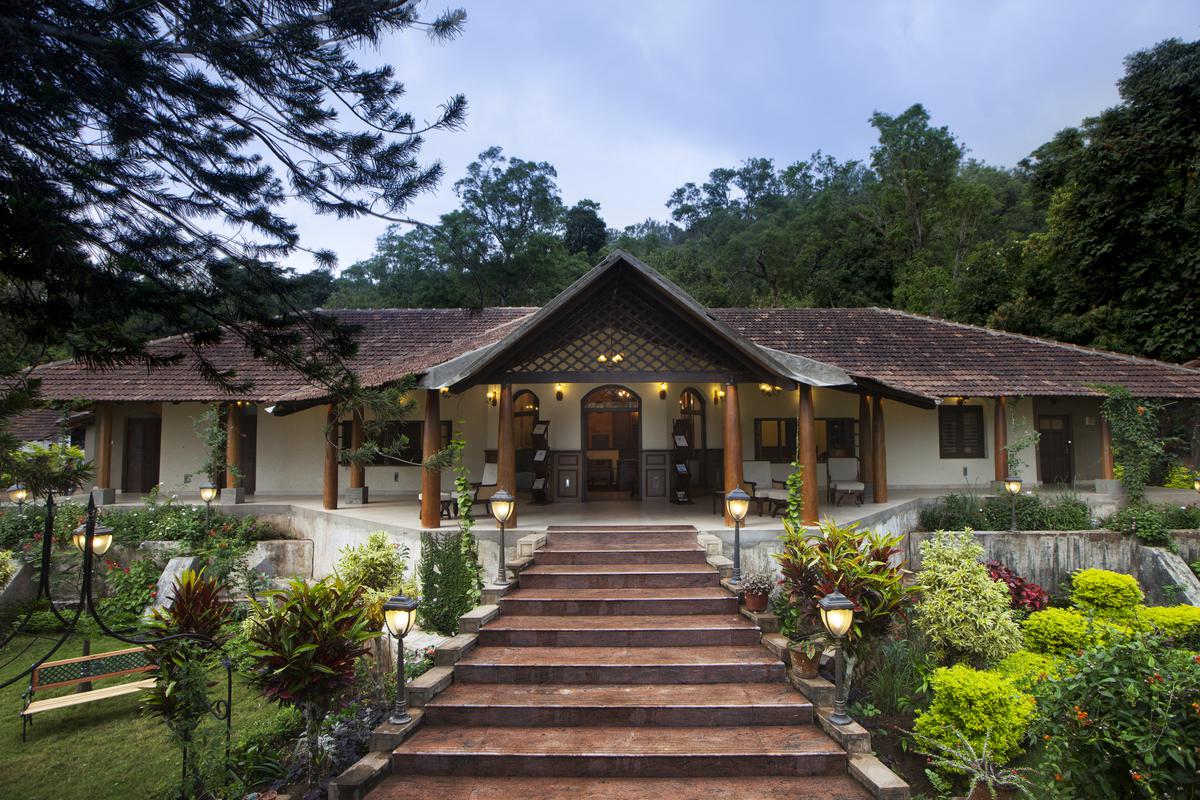Rolling hills and centuries of heritage — India’s sprawling estate bungalows are the new favourite getaway for families embracing summer vacations after a two-year gap
Rolling hills and centuries of heritage — India’s sprawling estate bungalows are the new favourite getaway for families embracing summer vacations after a two-year gap
Soft clouds kiss the mountaintops, as you sip tea from heritage porcelain. Walk to the local village, across a meandering stream to the tune of a blue throated barbet by day, and spend the nights stargazing. Or, sip on a fragrant cup of filter coffee at heritage plantation bungalow: it may be just the balm you need.
The weary urban traveller, cooped up at home for almost two summers, due to a global pandemic, is exulting in the freedom of summer vacations this year. 2022 is about slow travel, focusing on a connection to local people, cultures and food. A trip is then a vehicle for an emotional connection — it must educate you, while remaining sustainable for local communities and the environment.
Across India, such connections to the land can be drawn from stays at bungalows on tea and coffee estates, once a part of the British Raj, now owned and managed by families who seamlessly blend their way of plantation life with more conscious holidaying. Karthik Manikandan, CEO and founder of GT Travels in Chennai, adds that estate vacations are a big draw for families. “There has been a 50% increase in demand post-pandemic. Nature-oriented stays in tree houses and bungalows are especially popular in Coorg, Kumizhi and Valparai.”
Husna-Tara Prakash, owner and managing director at Glenburn Tea Estate & Boutique Hotel, Darjeeling, speaks of how the pandemic has drawn more Indians to their estate, “It’s been a complete turnaround. We had mostly international visitors before the pandemic, but it’s been such a positive experience with our Indian visitors, At Glenburn, situated on a hillock above the banks of the River Rungeet, overlooked by the Kanchenjunga mountain, the tea has a story to tell.
Reclined in Burma teak
Started by a Scottish tea company in 1859, the estate passed into the hands of one of the country’s pioneering tea planting families — The Prakashes in 2001. Today, the third and fourth generation Prakash family carry forward this legacy, creating a tea estate experience inspired by the vineyards of Europe. One can find slivers of history in each facet at Glenburn estate: antique furniture, old Burma teak floors and restored old cast iron window frames. The estate offers stunning vistas of the mountain range, and guests are treated to old-fashioned hospitality, replete with hand-embroidered linen by artisans from villages in Hooghly, West Bengal.
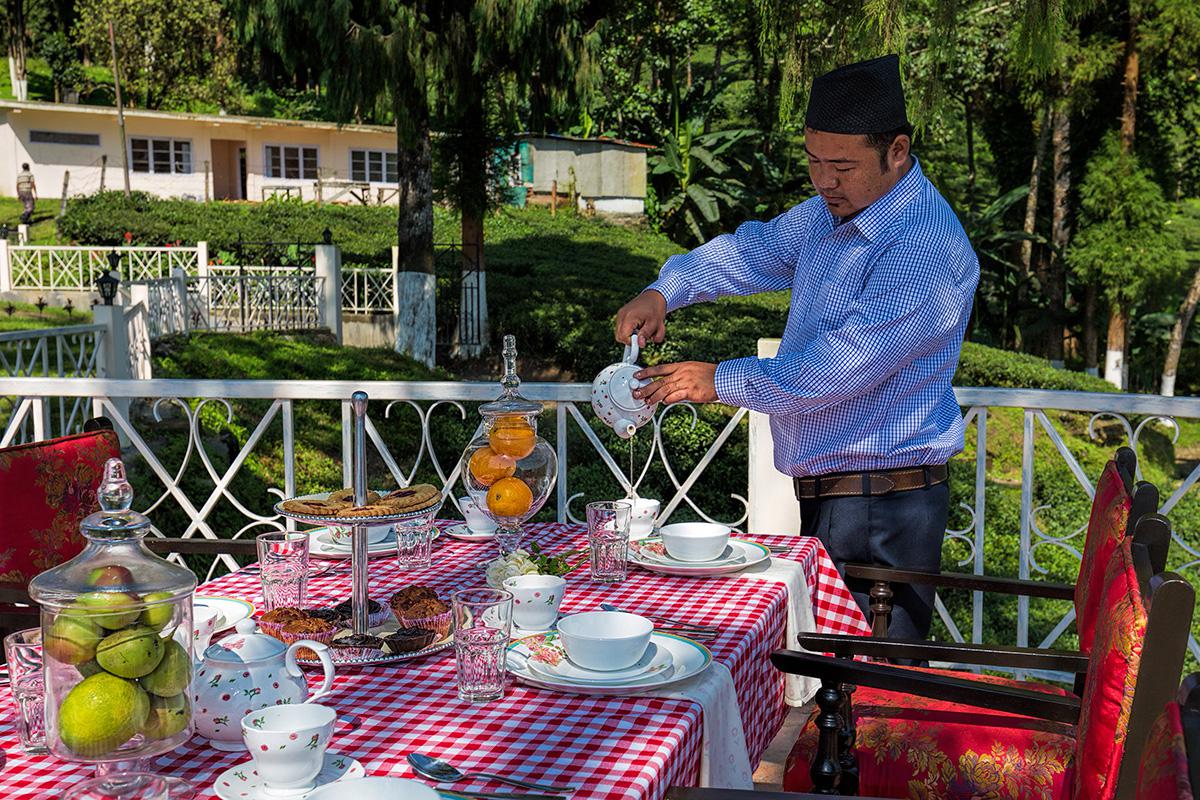
Tea service at Ging Tea House, Darjeeling
| Photo Credit: ANUP KANODIA
Tea gardens in North-East India are just as rich in legacy. At Ging Tea House, a heritage plantation retreat at Darjeeling, tea meets tradition as visitors can partake of local culture , and immerse themselves in the tea experience: visiting the gardens, witnessing the manufacturing process set by the East India Company, and ending with a tasting of the estate’s range of teas.
Built in 1864, the tea house has been tastefully restored keeping its colonial heritage intact, surrounded by manicured private gardens. The six suites are replete with old wooden flooring, exposed rafters on the high ceiling, and period furniture and drapes. The dining room, graceful with antique china, hosts long lunches and three-course evening meals. Breakfast is served on the open deck, which looks over the rolling tea gardens. It is a tapestry of heritage woven with modern comforts.
From the Northern mountains covered in lush tea leaves, as you move to coffee estates in the South, you will find nestled in what is often called the Scotland of India, Coorg, a heritage plantation dating back centuries. Old Kent Estates and Spa, one of India’s oldest coffee plantations, was developed in the 1800s by Lieutenant Colonel WR Wright, an army officer in British India. His oversight and planning transformed the estate from a jungle in which big game thrived to a highly cultivated, thriving estate. After his demise in 1898, the property remained with his descendants until 1964, when it was bought by its present owners, the Thaikappa family, from southern Tamil Nadu. The estate was formerly called Horoor Estate, drawing its provenance from a varietal of Arabica coffee popular with local planters.
At Old Kent, the majestic estate lodge and reading room house old photographs of Lt. Col. Wright’s collection as well as his elegantly drafted title deeds. “We want to make the plantation stay sustainable and preserve our heritage buildings. We offer a different experience compared with homestays or a hotel, it’s a personalised service that is both luxurious and offers exclusivity,” explains Sadat Sathak, CEO, who manages operations at the plantation. The lodge has been restored to invoke a sense of nostalgia — guests can borrow books from the library bathed in hues of mahogany brown, try the home theatre, play a game of billiards, or walk in the vegetable garden.
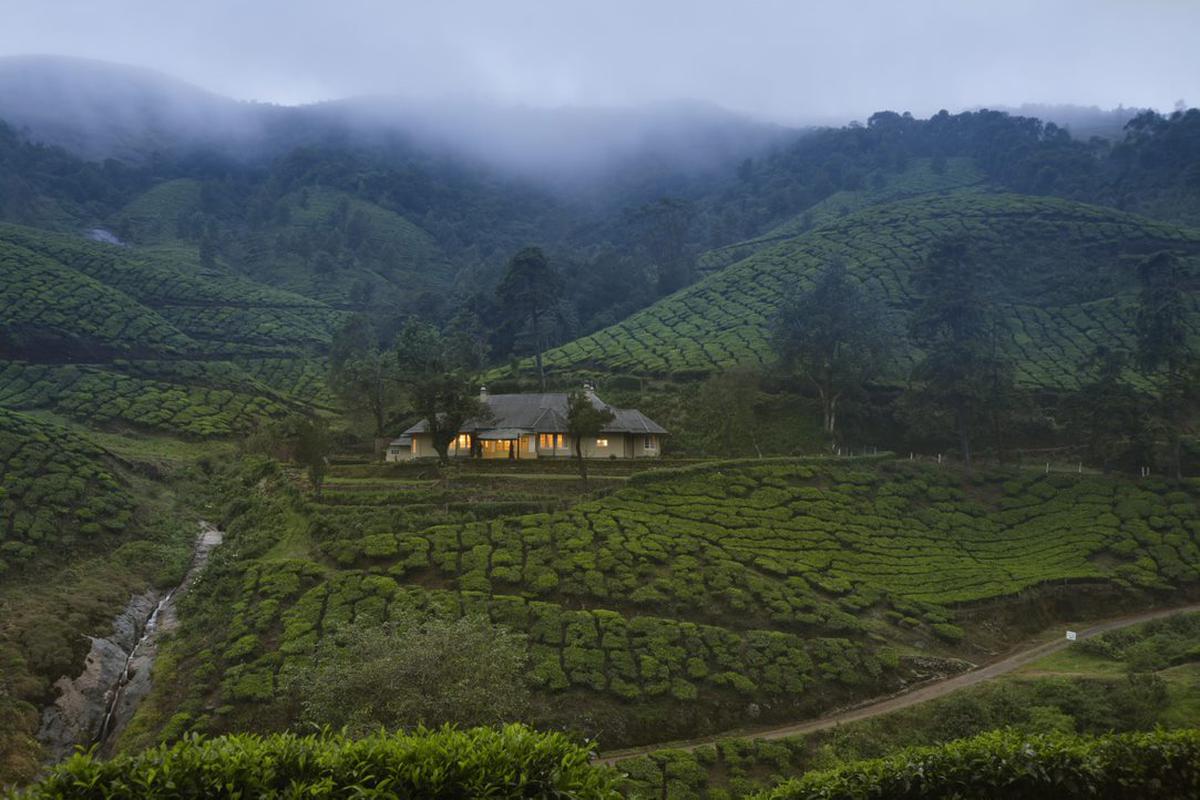
Sholamallay Estate in Munnar is now a part of IHCL’s amã Stays & Trails
| Photo Credit: Special arrangement
Across state lines in Kerala, the Sholamallay Bungalow, which is over 100 years old, is located in Nullatanni Estate, previously known as Sholamallay Estate in Munnar. It is now part of the Indian Hotels Company Limited (IHCL), a Taj Group subsidiary, that offers vacations at plantation bungalows through amã Stays & Trails, across the country. The painstakingly-restored three-bedroom bungalow used to house the estate planters and officers. From here, visitors can scan unending vistas of the plantation.
This is a common thread among India’s heritage plantation bungalows: visitors can enjoy a serving of history, mixed with the local culture and a bounty of Nature. At the Parisons Plantations in Wayanad, resort manager Binoy Gopi, maintains that a communion with Nature is just what the doctor ordered for travellers breaking free of travel restrictions. “Since the pandemic, we have seen a 30% increase in occupancy. Families enjoy their visits here, and our heritage style banglas are well-loved.”
A room at Parisons Plantations in Wayanad
| Photo Credit: Special arrangement
Husna-Tara says that at Glenburn, the new spurt of Indian guest “enjoy the estate stay, bird watching and being pushed out of their comfort zone to explore and experience the estate, by our staff.” Visitors can go on hikes to the Glenburn campsite on the river Rangeet, on fishing trips, or visits to local villages.
Guests are accommodated in one of two bungalows, each comprising four suites and common areas, gardens, verandahs and terraces accessible to all guests. The Burra Bungalow, restored in 2002, home to generations of planters, comprises a main verandah, a living room with a fireplace and library, and a grand dining room that hosts candle-lit sit-down dinners. The Water Lily Bungalow, with four more suites, has two verandahs and garden areas laid out on two levels.
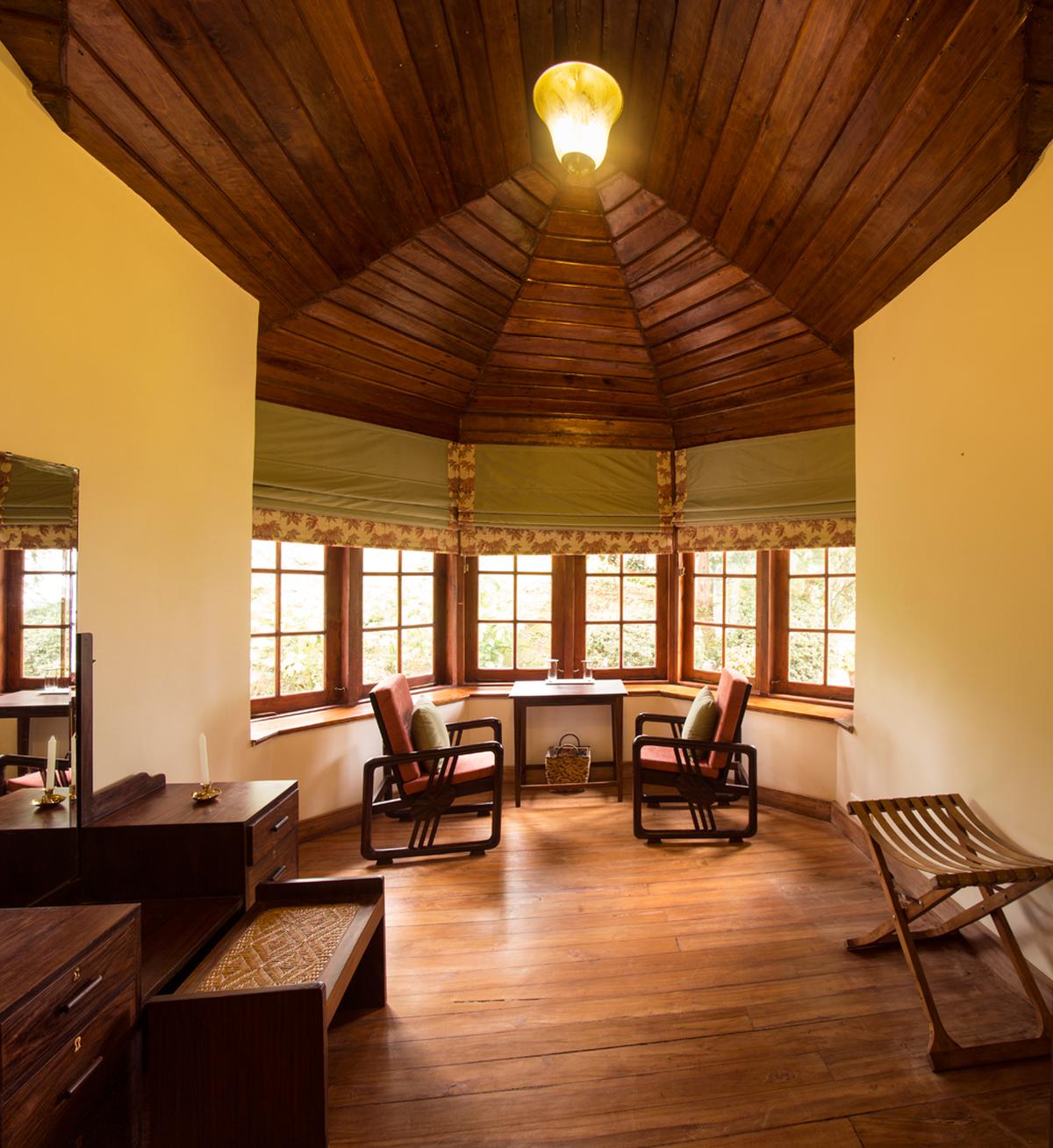
A room called Brock’s Bedroom in Sinna Dorai, Anaimalai
| Photo Credit: Special arrangement
What’s in a name?
Architectural and natural grandeur are also on offer at at Sinna Dorai in the South, with properties spread across Kerala, Tamil Nadu and Karnataka. The title gets its provenance from the term used for an assistant manager of a South Indian tea plantation. During British times, managers at the estate were called ‘periya dorai’ or ‘bada saheb’ and assistant managers were called ‘sinna dorai’ or ‘chhota saheb’. The bungalow at Anamallai Hills, Tamil Nadu, was built in the 1940s and offers six-bedrooms amidst acres of organic tea fields overlooking the Roti Kadai valley, the location of the first bakery in the district.
Elsewhere in the Nilgiris, MangoRange, built in 1918 and named after the mango tree in its vicinity, is a three-bedroom bungalow that still stands in its original form on the 2,500 acre Carolyn Estate. The English and Scottish Joint Wholesale Society Ltd acquired tracts of land in the Pandalur and Devala area and began planting tea in 1916, today covering 2,500 acres. In Karnataka, Kadu Mane (meaning ‘a house in the forest’) was opened as a tea plantation in the late 1920s with the nine-bedroom bungalow was built in 1930, as a twin house for the two Sinna Dorais who planted the tea that surrounds it.
Coffee time at Old Kent Estate and Spa, Coorg
| Photo Credit: Special arrangement
For the crop, after all, is central to all the luxury.
The 200-acre coffee plantation at Old Kent is home to some of the oldest cultivars of coffee, pepper and cardamom, as well as the Old Kent “shade-grown” coffee: the crop grows under the shade of a large canopy of trees and is enriched by its interdependence of the flora and fauna surrounding it. Mohammed Affan, Shoemaker at Bridlen, in Chennai, enjoyed his stay at the estate. “It definitely allows you more privacy and you’re closer to Nature, which was very important for my young kids. We had friends visiting from Europe, and they loved the coffee and experience here,” he says.
Tea tasting session at Glenburn Tea Estate, Darjeeling
| Photo Credit: Special arrangement
Most of these heritage estates encourage visitors to enjoy the coffee or tea experience, from the picking of leaves or berries, to a factory tour that ends with a tasting. A new experience on offer now is a visit to an organic farm, created on an old orange orchard, a short hike from the main estate. “We have a walk through the farm, that’s a treat for the five senses, with water flowing through, birdsong, Tibetan prayer flags and bells, and a cornucopia of local vegetation. We restored the land to create local Nepali farming techniques, and we have local utensils and a Nepali thali meal served at the farm,” explains Husna-Tara Prakash.
Recipes from the past
At Munnar’s Sholamallay Bungalow in Munnar local culture is a big draw. Families tour the local tea museum, enjoy a picnic by day and a bonfire under a star spangled sky. Local cuisine is prepared by in-house chefs, using recipes passed down generations, with both British and Tamil influences from the planters who once stayed here. One can also cook with the chefs, familiarising themselves with the flavours of Kerala. Shraddha Kulkarni, who works for the non-profitSenior, Manager, Programmes, Girl Effect, says her stay at a plantation bungalow was luxurious, “The colonial style bungalows with butler service was definitely a different experience. The love with which we were served our meals showed us how much the staff cared about the estate.”
Tea service at Glenburn
| Photo Credit: Special arrangement
Food is a big draw at Old Kent Estate as well, which offers Karnataka delicacies like kadamputtu, akki rotti, a jackfruit poriyal dish served seasonally, and a mushroom and bamboo shoot preparation, a favourite with the local chefs. “We offer some Anglo-Indian style dishes too like potato vindaloo, meatball curry, and all our jams are sourced from our neighbour Ms. Ponappa, whose dairy farm supplies the milk to the estate kitchen,” adds Sathak.
Similarly, at the Ging Tea House in Darjeeling, “Menus are made from fresh, seasonal produce and we try to give you our own little farm-to-fork experience with our chef picking vegetables from our organic kitchen garden,” explains a spokesperson, adding, “In the evening we arrange a bonfire in the gardens with our local guitarists singing folk songs, popular Bollywood and English hits. We also do barbecue by the fire.” For history buffs, there is a vintage grand billiards table crafted in the early 1800s, or an antique piano in mint condition. Families staying at Ging can also soak in the local culture with village walks visiting local Nepali temples, houses, schools and football matches.
Additionally, Ging offers its guests guided birdwatching tours to catch a glimpse of over 100 local avian species. It is not alone: Sadat Sathak states that Old Kent Estate & Spa offers an expert tour of the estate with renowned mountaineer, Lorenzo Gariano, or visitors can carve a path into the woods, searching for the centuries-old bear tree, Karadi maram.
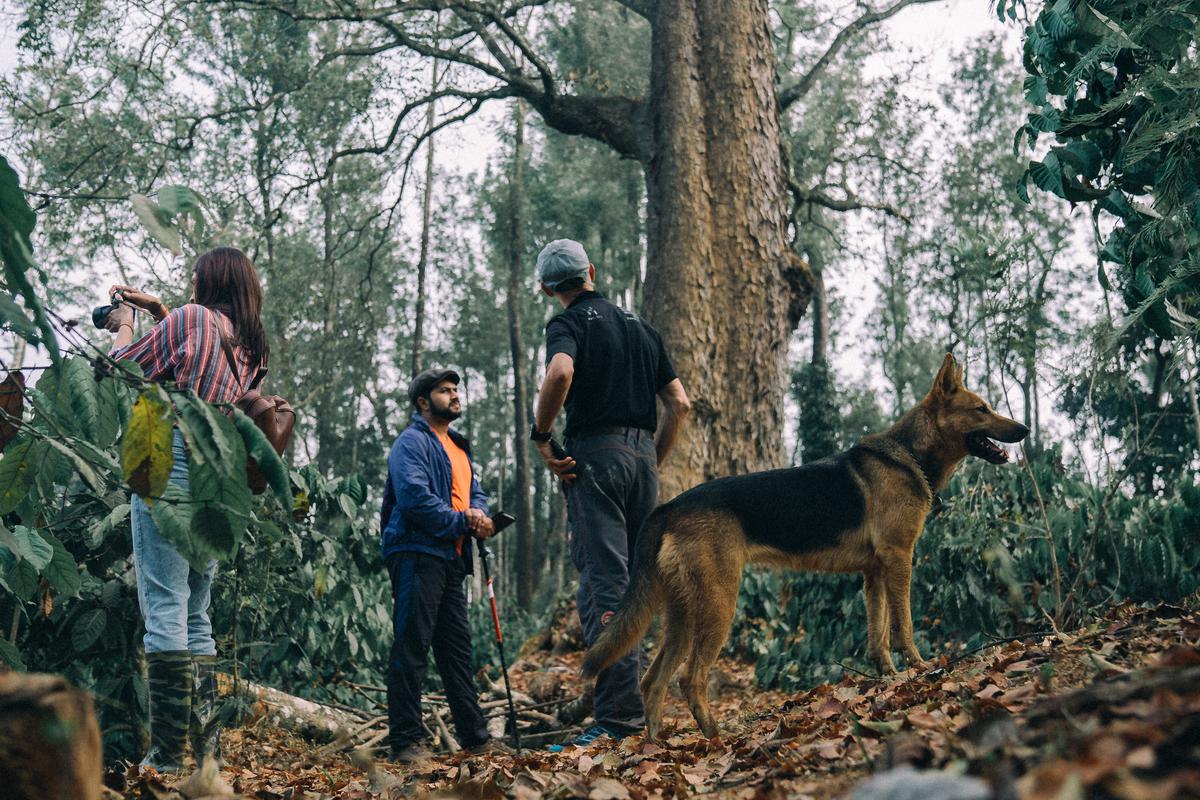
Mountaineer Lorenzo Gariano helps guests at Old Kent explore the estate
| Photo Credit: Special arrangement
Families looking for vacations that mimic living on a wildlife sanctuary, will find estates that are teeming with fauna of all kinds. Meenu Nair, manager at the Paralai Estate in the Anamallais, says visitors often find treks through the plantations invigorating: “You can spot elephants, the gaur, lion- tailed macaque and the Great Indian Hornbill.” Wild boar, Malabar squirrels and scarlet minivets also run free on the estates in the hills.
Letting the future in
But you need not go chasing wildlife at every estate. Comfort is priority, and many have added more facilities post-lockdown. For instance, with eight cottages spread across the premises and more rooms under construction, Old Kent did not offer wi-fi before the pandemic. “The situation forced us to rethink that decision and some families came in for longer stays, and they’d work or attend online school during the day and then enjoy the estate in the evenings”, adds Sathak.
Shraddha Kulkarni, who works for the non-profit Girl Effect, found her recent stay at a plantation bungalow luxurious, “The colonial style bungalows with your own butler service was definitely a different experience. The love with which we were served our meals showed us how much the people cared about the estate.”






















